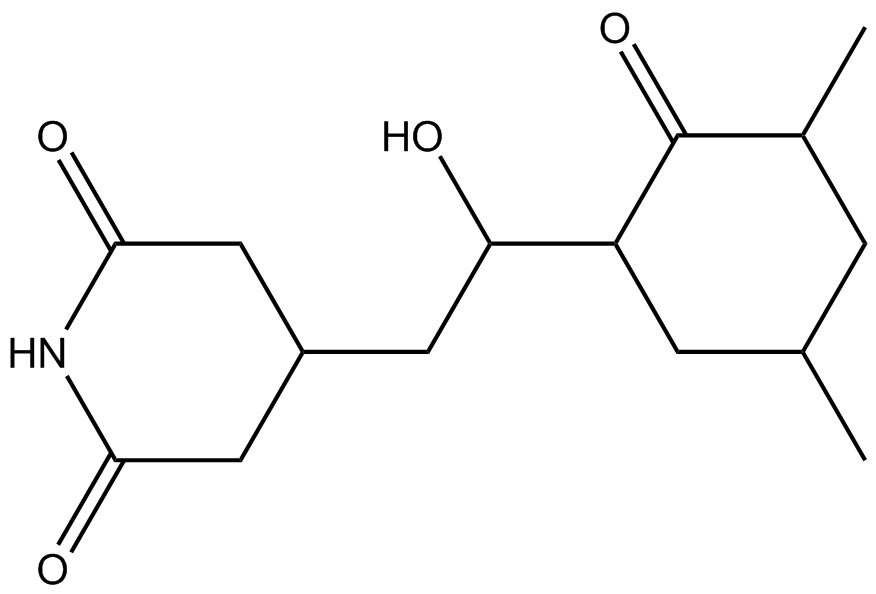Introduction
Description:Cycloheximide is used as an antimycotic and has shown activity against many yeasts, molds, and fungi.
See product info sheet for more information.
| Solubility |
Water |
| Physical Form |
Solid |
| Storage Temp. |
2 to 6 °C |
| UPC / SKU |
C1989 |
| CAS NUMBER |
66-81-9 |
| Formula Weight |
281.36 |
| Formula |
C15H23NO4 |
| Synonyms |
4-[2-(3,5-Dimethyl-2-oxo-cyclohexyl)-2-hydroxyethyl]-2,6-piperidinedione |
| Storage Temp. |
2 to 6 °C |
| Tariff Code |
2941.90.1050 |
| Risk Info (R) |
61-28-51/53-68 |
| Safety Info (S) |
53-45-61 |
No information available
C1989 Cycloheximide
| Synonyms: |
Actidione, Naramycin A, 3-[2-(3,5-Dimethyl-2-oxocyclohexyl)-2- hydroxyethyl]glutarimide |
| CAS: |
66-81-9 |
| Formula: |
C15H23NO4 |
| Mol. Weight: |
281.4 |
| Properties |
|---|
| Form: |
Powder |
| Appearance: |
White to Cream |
| Application: |
Antibiotic |
| Solubility: |
Solubility per the Merck Index in Water at 2% (w/v) or 20 mg/mL Also soluble in DMSO, Ethanol and other common organic solvents except saturated hydrocarbons |
| Typical Working Concentration: |
100 – 1000 µg/mL |
| Storage Temp: |
2 to 6 oC |
| Storage Temp of Stock Solution: |
The Merck Index indicates that in aqueous solution at pH 7, activity is destroyed after 1 hr boiling but not after 15 min boiling. At pH 2 no loss of activity after 1 hr boiling. At room temperature, decomposes rapidly and forms 2,4-dimethylcyclohexanone in dilute alkali conditions. |
| Other Notes: |
Contains the macro- and micronutrients and vitamins as described by Gresshoff and Doy (1974). |
Application Notes
Cycloheximide is a glutarimide antibiotic derived from Streptomyces griseus. It is active against most yeast and fungi and is often used in bacteriological media for isolation and counting of unknown bacteria. It has been reported that cyclohexmide inhibits eukaryotic protein synthesis.2 Cycloheximide has also been used as a plant growth regulator by inducing the production of ethylene in plants.3, 4
Please Note: It is the sole responsibility of the purchaser to determine the appropriateness of this product for the specific plants that are being cultured and applications that are being used.
References
1. Merck Index, 13th Ed, #2757
2. Schneider-Poetsch, Tilman, Jianhua Ju, Daniel E Eyler, Yongjun Dang, Shridhar Bhat, William C Merrick, Rachel Green, Ben Shen, and Jun O Liu. 2010. Inhibition of Eukaryotic Translation Elongation by Cycloheximide and Lactimidomycin. Nat Chem Biol. 6(3). 209-217.
3. Steen, David A. and Arthur V. Chadwick. 1973. Effects of Cycloheximide on Indoleacetic Acid-induced Ethylene Production in Pea Root Tips. Plant Physiol. 52. 171-173.
4. Wang, Kevin L. Hai Li, and Joseph R. Ecker. 2002. Ethylene Biosynthesis and Signaling Networks. Plant Cell. May. 14. S131-S151.




